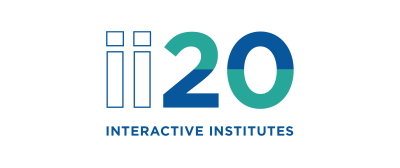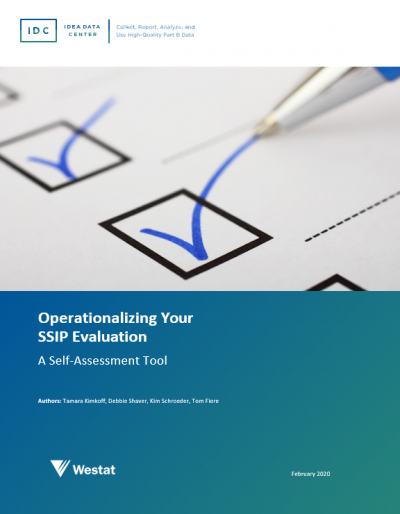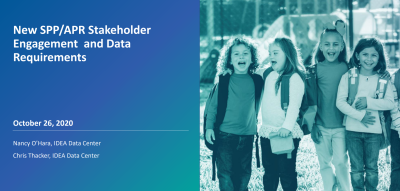Site Search
Results 15 - 21 of 47
-
New SPP/APR Stakeholder Engagement and Data Requirements
IDC’s October webinar focused on two primary areas of change in the new SPP/APR package: Stakeholder Engagement and SPP/APR Data Requirements. Presenters helped states understand the new stakeholder engagement and data requirements and identify potential actions they can take to prepare for timely implementation of these changes. Presenters payed specific attention to data source changes for indicators 1, 5, 6, 13, and 14. In addition, participants heard state perspectives on how state staff are conceptualizing or implementing new approaches to meet the new requirements.
Format: Toolkits
Preschool Environments ToolkitThe Preschool Environments Toolkit provides materials and resources to help state education agencies (SEAs) and local education agencies (LEAs) collect, report, analyze, and use preschool environments data. State Part B data managers, 619 coordinators, local 619 personnel, technical assistance providers, and other interested parties can use the toolkit to help them report Educational Environments data for children ages 3 through 5 with disabilities enrolled in preschool and receiving services under Part B of IDEA. The toolkit includes materials related to IDEA Section 618 federal reporting requirements and populating Part B SPP/APR Indicator 6, and it offers a Preschool Environments Calculator and Data Analysis Tool to help states calculate and analyze Indicator 6 preschool educational environments data.
Format: Applications and Spreadsheets
Part B Indicator Data Display WizardThe IDC Part B Indicator Data Display Wizard helps state education agency (SEA) staff communicate complex data to stakeholders in a more user-friendly manner. This tool is designed to create data visualizations, in the form of charts, based on State Performance Plan/Annual Performance Report (SPP/APR) data the user enters. IDC has updated the tool to make it easier for users to create visualizations based on the charts’ purposes. Many of the visualizations are dynamic and automatically update based on the data the user enters into the tool. States can easily transfer the visualizations to other programs to meet their reporting needs based on the audience, message, and purpose of the desired report or presentation they are preparing.
Format: Guides and Briefs
Parent Involvement Data: How to Measure and Improve Representativeness for Indicator B8This interactive resource provides states with an overview on how to gather representative parent involvement data for Part B SPP/APR Indicator 8. The resource defines key concepts such as representativeness, sampling, nonresponse bias, response rates, and weighting. It also offers information on how to improve the quality of parent involvement data, including strategies that can help states collect representative data and evaluate and improve the representativeness of their data before, during, and after data collection.
Format: Trainings
OSEP Straight TalkThis OSEP Straight Talk plenary at IDC’s 2020 Interactive Institute in Fort Worth this past March presented information on how to access Coronavirus guidance from the Centers for Disease Control and the Readiness Emergency Management for Schools Technical Assistance Center. The presentation offered a look at what’s new at OSEP and featured updates on major OSEP initiatives and work of OSEP’s Research to Practice and Monitoring and State Improvement Planning divisions. Participants learned about resources on restraint and seclusion; OSEP’s release of 10 new 618 data files; current investments to support data use; and how to access the OSEP TA&D network. They also learned about key OSEP efforts related to the SPP/APR, differentiated monitoring and support, state Part B and Part C grant applications, and the new significant disproportionality reporting form.
Format: Guides and Briefs
Operationalizing Your SSIP Evaluation: A Self-Assessment ToolThe purpose of this tool is to lead those within a state responsible for implementing their SSIP evaluation through the process of operationalizing their SSIP evaluation plan in tandem with implementation efforts. State staff can use this interactive self-assessment to gauge their team’s progress on key components necessary for fully executing their SSIP evaluation plan and to identify action steps needed to realize the greatest benefit from their evaluation efforts.
Format: Quick Reference
Navigating Uncharted Waters: Engaging Stakeholders in Part B Indicator 3 Baseline and Target SettingThis customizable resource includes a PowerPoint template and presentation notes that provide states with an overview of the Part B SPP/APR reporting changes to Indicator 3, which addresses participation and performance of children with individualize education programs (IEPs) on statewide assessments. The resource reviews the new requirements related to stakeholders, particularly parents, in the SPP/APR and implications for Indicator 3 and shares strategies for engaging stakeholders in the optional baseline and required target setting processes. States are able to customize the information in the PowerPoint to reflect their own contexts and to meet the needs of different audiences.








